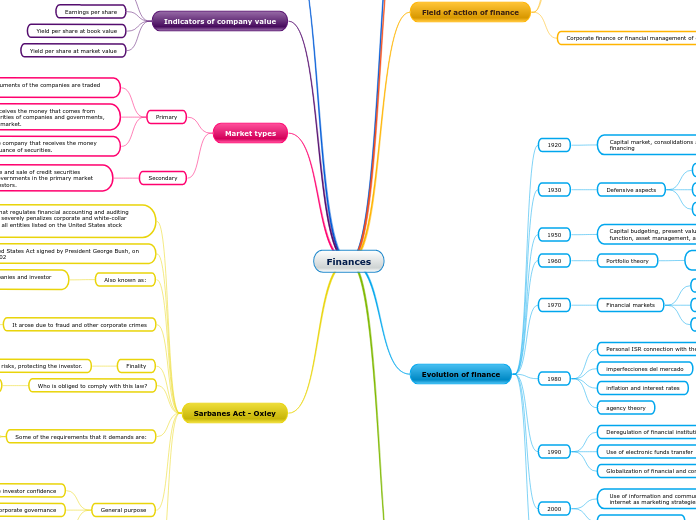Finances
Sarbanes Act - Oxley
Reinforced
Monitoring of these controls
Establish an application guide
Establish internal controls in companies
The application of the report (COSO)
General purpose
Control activities at the corporate level
Improve corporate governance
Restore investor confidence
Some of the requirements that it demands are:
That the managers accompany the reports with a personal certification
Define new responsibilities and functions of the audit committee, which should have members independent of the administration.
Establish a new council, overseen by the SEC
Who is obliged to comply with this law?
All listed companies and their subsidiaries
Finality
Avoid fraud and bankruptcy risks, protecting the investor.
It arose due to fraud and other corporate crimes
Most renowned cases
WorldCom
Xerox
Enron
Also known as:
Act of Reform of public accounting of companies and investor protection (SOX, SarbOx)
It is a United States Act signed by President George Bush, on July 30, 2002
It is the law that regulates financial accounting and auditing functions and severely penalizes corporate and white-collar crime against all entities listed on the United States stock exchange.
Market types
Secondary
The transactions of purchase and sale of credit securities issued by companies and governments in the primary market are negotiated between investors.
Primary
In public issues, it is the company that receives the money that comes from the issuance of securities.
It is the company that receives the money that comes from the issuance of debt securities of companies and governments, issued through the stock market.
The shares or debt instruments of the companies are traded on the stock market.
Indicators of company value
Yield per share at market value
Yield per share at book value
Earnings per share
Net profit
Dividend theories
Signaling theory
It establishes that shareholders always expect dividends as a sign of the good performance of the company. Dividends are a priority that should not be neglected.
'' RESIDUAL THEORY OF DIVIDENDS ''
The profits generated in a period of operations must be allocated to projects whose profitability meets the expectations of the shareholders; if profits are still available, dividends must be shared among them.
Types of financial manager decisions
Dividend policy
Asset Management
Financing
Investment
Evolution of finance
2010
Sustainable development projects of organizations
The value of intangible assets
Risk management
Convergence of financial information
2000
Stakeholder participation
Use of information and communication technologies and the internet as marketing strategies
1990
Globalization of financial and commercial operations
Use of electronic funds transfer
Deregulation of financial institutions
1980
agency theory
inflation and interest rates
imperfecciones del mercado
Personal ISR connection with the company's ISR
1970
Financial markets
Option pricing model
Arbitrage pricing model
Possibility of negotiating debt and capital securities
1960
Portfolio theory
Marginal contribution of each asset to the overall risk of the company's portfolio.
1950
Capital budgeting, present value, time value of money function, asset management, analysis for decision making
1930
Defensive aspects
Reorganizations
Liquidations
Bankruptcy
1920
Capital market, consolidations and mergers, liquidity and financing
Field of action of finance
Corporate finance or financial management of companies.
Responsibilities of the financial manager
Relationship with financial markets
Coordination and control of operations
Administration of accounts receivable and cash
Investment decisions and financing of capital goods and inventories
Long-term planning and budgeting
Increasing importance of financial management
Create wealth for the shareholder
Physical person with business
Institutions and financial markets
They specialize in selling, buying, creating credit titles and securities.
Investments
How to make and how to manage an investment in financial assets.
Types of Assets
Financial
It constitutes the right to collect an account.
Real
Tangible asset, used to generate resources
Finance concept
Finance is the branch of economics that is related to the study of investment activities both in real assets and in
financial assets and their administration

